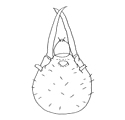Families consist of Masotermitidae, Rhinotermitidae and Termitidae.
They build nests in the soil and are very dependent on soil for moisture. In their search for food, subterranean termites construct mud tubes because they are susceptible to desiccation when exposed to air. They usually work their way above ground to reach wood or any other cellulose source. The cellulose is then broken down into simple starch with the help of protozoans in the termites’ gut.
A important subterranean termites that belong to family Rhinotermitidae is Coptotermes gestroi
All species of the genus Coptotermes may be separated from species of other genera by the following characteristics:
- The soldier have pear-shaped heads
- The size of the soldiers is between 3.5 mm and 6.5 mm
- A white material is exuded from a pore in the head of soldiers when they are disturbed
 |
Pictorial key to Coptotermes spp. - Fontanella prominent, tubelike, arising on top of head, extending almost to front margin, head egg-shaped. |
General Treatment of Subterranean Termites
- Soil treatment is the principal method used in control, and widely varying types of construction.
- Using baits for termite control is another method that involves different consideration.
- Physical barriers such as metal screens is a third method requiring another set of consideration. Termatrac Technology.
Non-subterrannean Termites:
Mandibles with teeth (A)
Pronotum wide as or wider than head (B)
Subterrannean Termites:
Each mandible with at most one tooth on inner margin ©
Pronotum narrower than head (D) |


